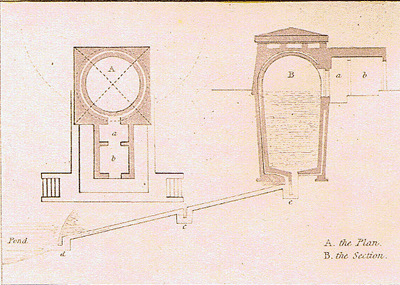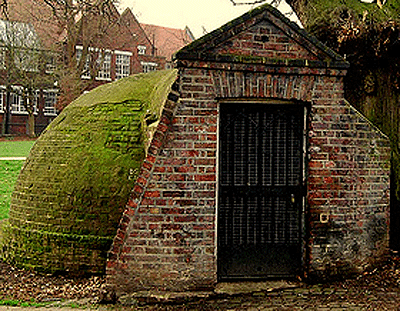The ice house uncovered
Many country estates had ice houses in the 18th century - could you re-instate yours as a more eco-friendly fridge?

As an architectural historian I research many different types of buildings and houses. But one of my abiding interests is the English Ice House. More exist today than is realised. Their very subterranean nature means they are out of sight and therefore tend to be forgotten. Certainly whether an ice house has any use or purpose in the 21st century is questionable. But there may be hope.
So what exactly is an icehouse? Well, it is a subterranean structure, built and used for the storage of ice and in turn for the preservation of food. When ice is packed together, its relatively small surface area slows down the thawing process. Ice will of course, last longer if kept at a regular low temperature and insulated by straw, thick walls and a roof.
An ice house tends to be located close to a water source, such as a lake, in order to easily harvest ice in the depths of winter. Ice houses also have a drain hole in the base for the slow-melting ice to drain away. However, because of their temperature control efficiency a full ice house could take up to 18 months to thaw.
James I of England commissioned the construction of the first modern ice house in Greenwich Park in 1619. Medieval versions, known as ice pits, have not survived but it is likely that what set them apart from the new 17th century design was that the latter's walls were brick-lined and their cylindrical shape, engineered for temperature regulation and strength.

The Greenwich Ice House drawn in 1772 by Hieronymous
Grimm
King James commissioned another ice house (or snow conserve) to be built at Hampton Court in 1625-6. It is known to have been a brick-lined round well, 30 ft (9.1 m) deep and 16 ft (4.8m) wide and covered with a thatched timber building. While there were variations in this design and ice houses also varied greatly in size, this early 17th century model set the standard for future constructions.
Exquisite houses, the beauty of Nature, and how to get the most from your life, straight to your inbox.
Four decades later the grandson of James 1, Charles II, was a man who promoted and patronised science and technology. One key example of this was the construction of an ice house in Upper St James's Park (now Green Park) in London in 1660. This scientific project also enabled Charles to entertain and impress by providing chilled drinks and ices to his retinue and guests, even in the height of summer.
This ice house was so noteworthy that the poet Edmund Waller wrote in 1661:
ON ST JAMES'S PARK (As lately improved by His Majesty)
Yonder the harvest of cold months laid up, Gives a fresh coolness to the royal cup, There ice, like crystal, firm and never lost, Tempers hot July with December's frost; Winter's dark prison, whence he cannot fly, Tho' the warm spring, his enemy draws nigh: Strange! That extremes should thus preserve the snow, High on the Alpes or in deep caves below.
The 18th century saw a significant increase in the number of ice houses being constructed, mainly serving great manor houses and their estates. But rural manor houses were not the only ones to keep up with the rising trend in ice and food preservation. London of the 1700s experienced rapid growth including the construction of grand houses and villas, for new wealthy individuals. So it was during this period that what was once the preserve of royalty became accessible to the gentry and well-to-do.

John Buonarotti Papworth's 1818 Design for an Ice
House
In the 19th century vast, industrial quantities of ice tended to be sourced from North America and Norway. These fed the ice houses of the country estates, as well as commercial ice stores in the cities and private ice wells in smaller domestic houses. (Ice was also shipped to India from North America with an impressive 50% of the frozen cargo surviving the voyage). It was only the invention of the refrigerator at the end of the 19th century that saw the end of the ice trade and the demise of their brick-lined stores.

Woodlands Park Ice House, Acton
Between 1939 and 1945 old ice houses did find new purposes. Some were reinstated as ice and food stores, but many, by virtue of being subterranean and strongly built became air raid shelters. Since World War II ice houses have been used as garden sheds, fruit stores, wine cellars or, if there are sufficient entry points, as bat roosts. However, in these eco-friendly days; at a time when traditional building techniques and other old ways are seen to be "greener", it could be considered carbon-wise for those lucky enough to have one, to ditch the electric fridges and freezers and reinstate their ice house for its original purpose!
Ellen Leslie BA (Hons) Dip. Cons. (AA) is an architectural historian who researches and assesses buildings for building conservation and property professionals and as well as private home owners. She studied at the Architectural Association's School of Architecture and attained the Postgraduate Diploma in the Conservation of Historic Buildings. Ellen had previously graduated with honours from Birkbeck College in Politics, Philosophy and History. She is an Affiliate Member of the IHBC. Ellen also blogs about her work on her Building Storeys page.

Ellen Leslie is a
member of ProjectBook which has been created to help owners of listed or period properties understand
how their buildings work and to help them find appropriate craftsmen, products
and specialist
information. The online Heritage Register contains over 540 registered
businesses, the largest directory of its type in the UK. For more information,
visit www.projectbook.co.uk
Country Life is unlike any other magazine: the only glossy weekly on the newsstand and the only magazine that has been guest-edited by His Majesty The King not once, but twice. It is a celebration of modern rural life and all its diverse joys and pleasures — that was first published in Queen Victoria's Diamond Jubilee year. Our eclectic mixture of witty and informative content — from the most up-to-date property news and commentary and a coveted glimpse inside some of the UK's best houses and gardens, to gardening, the arts and interior design, written by experts in their field — still cannot be found in print or online, anywhere else.
